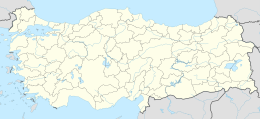This article needs additional citations for
verification. (September 2022) |
Gez Adası | |
|---|---|
| Geography | |
| Location | Aegean Sea |
| Coordinates | 39°22′N 26°42′E / 39.367°N 26.700°E |
| Administration | |
| İl (province) | Balıkesir Province |
| İlçe | Ayvalık |
Gez Adası ( English: Gez Island, also known as its outdated name Balık Adası) is a Turkish island in the northern Aegean Sea. [1]
The island is a part of the Ayvalık Northern Islands group in Ayvalık district of the Balıkesir Province, administered by Turkey and is located at 39°22'40"N 26°42'23"E. [1] The island is situated between Kutu Island (Also known as Küçük Karaada Island) and Yumurta Island with it being in close promximity to Akoğlu Island and Cunda Island. It is located 2.84 kilometers (1.76 miles) away from the shore and is currently uninhabited.
Toponymy
The historical name for the island is Daskaleió ( Greek: Δασκαλειό) with the island having a range of local names in Turkish such as Büyük Karaada (or simply Kara Ada [2]) and Balık Adası. The name Gez comes from the Turkish word "to travel" while another version of the island's name, Balık Adası, is derived from the word "Balık" in Turkish meaning fish. The name for nearby Kutu Island (Küçük Karaada Island) is related to another name of the island, Büyük Karaada. Büyük translates to "big" or "large" while Küçük translates to "small" in Turkish, meaning that the toponymy of these 2 islands were connected due to their proximity and size difference.
Historical artefacts
The island contains many historical Ancient Roman and Greek artifacts such as graves, tombstones, silver and gold coins because of its geopolitical location in the province of Asia as a part of the Roman Empire [3] and as a part of the ancient Greek city states. [4] Due to the island's historical nature, it has been subjected to illegal grave robbing and archeological looting in the past decade. [5] [6] Some of the island's historical artifacts date all the way back to the ancient town of Pordoselene, a tributary to City State of Athens, dating back to the 5th and 4th centuries BCE. [4] [7] [8] Nearby islands such as Büyük Maden Island contain similar archeological artifacts from the Pordoselene, indicating a group of ancient Greeks once inhibited the islands. [4]
References
- ^ a b "Geographical Location of Gez Adası". OpenStreetMap. Retrieved 2022-06-23.
- ^ "Turkish municipalities page". www.turkiye-belediyeleri.com (in Turkish). Retrieved 2022-06-23.
- ^ "Digital Atlas of the Roman Empire". imperium.ahlfeldt.se. Retrieved 2022-06-23.
- ^ a b c Mogens Herman Hansen & Thomas Heine Nielsen (2004). "Aeolis and Southwestern Mysia". An inventory of archaic and classical poleis. New York: Oxford University Press. pp. 1047, 1049–1050. ISBN 0-19-814099-1.
- ^ "Historical Artifacts stolen from Balık Adası (News Article)". medyaayvalik.com. Retrieved 2022-06-16.
- ^ "Illegal archeological digging in Balik Adasi news article" (in Turkish). Retrieved 2022-06-23.
- ^ Richard Talbert, ed. (2000). Barrington Atlas of the Greek and Roman World. Princeton University Press. p. 56, and directory notes accompanying. ISBN 978-0-691-03169-9.
- ^ Lund University. Digital Atlas of the Roman Empire.
